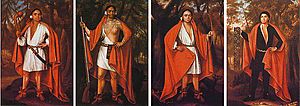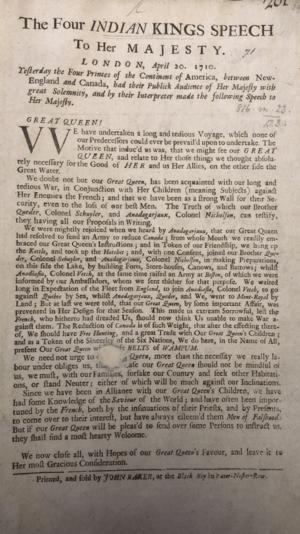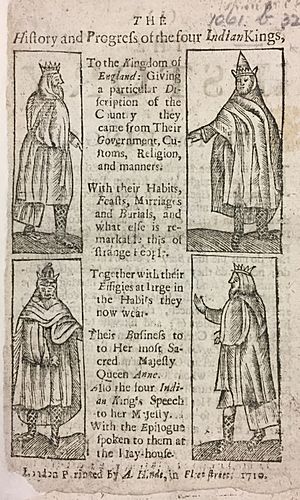Four Mohawk Kings facts for kids


The Four Indian Kings were three Mohawk chiefs and one Mohican chief. They traveled from New York to London in 1710. Their goal was to meet Queen Anne of Great Britain. They wanted to ask for help for their people.
The three Mohawk chiefs were part of the Iroquois Confederacy. Their names were:
- Sa Ga Yeath Qua Pieth Tow of the Bear Clan, also known as Peter Brant. He was the grandfather of the famous Mohawk leader Joseph Brant.
- Ho Nee Yeath Taw No Row of the Wolf Clan, also called John of Canajoharie.
- Tee Yee Ho Ga Row of the Wolf Clan, also known as Hendrick Tejonihokarawa or King Hendrick.
The Mohican chief was Etow Oh Koam of the Turtle Clan. The Mohican people spoke an Algonquian language and were not part of the Iroquois Confederacy. Five chiefs started the journey, but one died during the trip across the Atlantic Ocean.
Contents
Meeting the Queen
The four Native American leaders visited Queen Anne in 1710. This important trip was set up by Pieter Schuyler, who was the mayor of Albany, New York. When they arrived in London, they were treated like important diplomats. Royal carriages took them through the city streets. Queen Anne welcomed them at St. James Palace. They also visited famous places like the Tower of London and St Paul's Cathedral.
The chiefs had two main requests for the Queen. First, they asked for military help to defend against the French. Second, they wanted missionaries to teach their people. They hoped this would balance the influence of French Jesuits, who had converted many Mohawk to Catholicism.
Queen Anne listened to their requests. She told the Archbishop of Canterbury, Thomas Tenison, about their wish for missionaries. A mission was approved. The next year, Mayor Schuyler had a chapel built at Fort Hunter. This fort was near a Mohawk village called the "Lower Castle." Queen Anne sent a special gift: a silver Communion set and a reed organ for the chapel.
Most people in the "Lower Castle" village became Christian in the early 1700s. Another Mohawk village, the "Upper Castle" at Canajoharie, got a mission much later. In 1769, William Johnson, a British agent, built the Indian Castle Church there. This church still stands today.
Famous Portraits
To remember this important visit, the British Crown asked Jan Verelst to paint portraits of the Four Kings. These paintings were displayed in Kensington Palace for many years. In 1977, Queen Elizabeth II moved them to the National Archives of Canada. She personally showed them in Ottawa.
Their Time in London
During their stay in London, the chiefs lived at The Crown and Cushion inn. Their host, Thomas Arne, was very kind to them. Because of his kindness, the chiefs gave him a Mohawk name: Cataraqui. This name was also given to a fort that is now the city of Kingston, Ontario. It was their first time sleeping on beds, and they quickly got used to them.
The Four Kings were quite a sight in London. People described them as strong and muscular. They were almost six feet tall. Their skin was brown, and their hair was long and black. People said their faces looked "awful and majestick," meaning powerful and grand. Their faces had art on them, likely tattoos, which might have been meant to scare enemies in battle. They were also described as polite and willing to try any food or drink offered. They especially loved English beef. People also noted how healthy they were.
When they met Queen Anne, her court was in mourning. So, the Four Indian Kings wore all black clothes for the meeting. Their speech to the Queen was read aloud. They asked for military help and missionaries to guide them to "true religion." After the speech, the chiefs gave the Queen several belts of wampum. These belts were important gifts that showed their meeting and alliance.
Queen Anne was touched by their words. She discussed their requests with her advisors. She also talked with the four men through an interpreter, John Schuyler, who was Peter Schuyler's brother. The chiefs even offered to show the Queen their hunting skills by catching a deer without weapons, though it's not known if they did. In return for the wampum, the Queen gave them special communion plates for a future Mohawk chapel. These plates are now split between Mohawk lands in Brantford, Ontario, and Tyendinaga, near Kingston. The Archbishop of Canterbury gave each chief a Bible.
The chiefs also toured many places in London. They watched the Guards in Hyde Park. They visited the Banqueting House at Whitehall. They rode on the Queen's boat to Greenwich Hospital and the Woolwich Arsenal, where they heard cannons fire. They listened to sermons in churches. They were guests at a dinner hosted by the Board of Trade. They also enjoyed private meals with William Penn. They saw a puppet show and even sat on the stage during a play called Macbeth.
Impact of Their Visit
The Kings, along with Peter Schuyler, sailed home in May 1710. Their visit had big effects. It encouraged the British to go to war against French Canada. It also helped keep the Mohawk people on the English side in the conflicts that followed. The visit also led to a significant missionary effort. By royal order, a military fort and missionary center was built in the Mohawk area. This was Fort Hunter, near Amsterdam, New York.
No written records of the Four Indian Kings' own thoughts about their London trip exist. Their stories were passed down through spoken word, as was the Mohawk tradition.
Sa Ga Yeath Qua Pieth Tow (Peter Brant)
Sa Ga Yeath Qua Pieth Tow was one of the three Haudenosaunee (Iroquois) chiefs who visited Great Britain. He was a Mohawk Chief and part of the Bear clan. During his visit, Sa Ga Yeath Qua Pieth Tow was baptized and given the Christian name Peter Brant. He was the grandfather of the famous Iroquois leader Joseph Brant.
His portrait by Jan Verelst shows detailed tattoos. These tattoos are some of the best records of 18th-century Native American tattooing. Tattoos were made by stenciling a design on the skin. Then, needles or small bones were used to prick the skin until it bled. The exact meaning of his tattoos is not known. However, his detailed tattoos likely showed his high status as a leader and a warrior. Sadly, Brant died soon after he returned from London. Sa Ga Yeath Qua Pieth Tow was the brother of Tee Yee Ho Ga Row.
Ho Nee Yeath Taw No Row (John of Canajoharie)
Ho Nee Yeath Taw No Row was born in what is now Upstate New York. He was one of the three Haudenosaunee (Iroquois) chiefs who traveled to Great Britain. Ho Nee Yeath Taw No Row was baptized and then called John. He was a member of the Wolf Clan. This is why a wolf is shown with him in his portrait by Jan Verelst. Like the other chiefs, his tattoos, clothing, and special items showed his values and importance as a Native diplomat.
Etow Oh Koam (Nicholas)
Etow Oh Koam was a Mohican chief, not a Haudenosaunee chief. But he also traveled with the other chiefs to Great Britain. In Etow Oh Koam's portrait by Verelst, he holds a carved wooden club. This club shows his status as a warrior. Etow Oh Koam has a Thunderbird tattooed on his face. The Thunderbird was believed to be a powerful sky spirit. Wearing it was a symbol of spiritual support for a warrior.
Tee Yee Ho Ga Row (King Hendrick)
Tee Yee Ho Ga Row (baptized Hendrick) was the third of the three Haudenosaunee (Iroquois) chiefs who visited Great Britain. He was called the "Emperor of the Six Nations." In his portrait by Verelst, Tee Yee Ho Ga Row is holding a wampum belt. Wampum belts were very important to the Iroquois people. They helped remember meetings and represented strong alliances. An alliance could only be broken if the belt was returned.
The people of London described Tee Yee Ho Ga Row as tall and handsome. They said his skin showed "the shadowed livery of the burnished sun," meaning it was tanned from the sun. He was about thirty years old and a powerful leader among his people. He was known as a good friend to the English. Tee Yee Ho Ga Row traveled to England with his brother, Sa Ga Yeath Qua Pieth Tow.
Images for kids
-
Four Indian Kings painted by Jan Verelst, 1710. From left to right: Etow Oh Koam (Mohican), Sa Ga Yeath Qua Pieth Tow, Ho Nee Yeath Taw No Row, and Tee Yee Ho Ga Row.
-
The Four Indian Kings' Speech to Her Majesty, published in London by John Baker. This is a transcription of the speech that the Four Kings made to Queen Anne on April 20, 1710.
See also
 In Spanish: Cuatro reyes indios para niños
In Spanish: Cuatro reyes indios para niños




